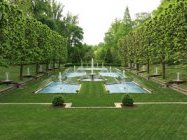Italian Garden In Landscape Design
 The Italian style begins its story in the age of Renezance. The garden that's done is intrigue its interesting forms and techniques. Italian garden is established under certain laws Regular gardenwhich characterizes the geometry and symmetry components and designs.
The Italian style begins its story in the age of Renezance. The garden that's done is intrigue its interesting forms and techniques. Italian garden is established under certain laws Regular gardenwhich characterizes the geometry and symmetry components and designs.
The Italian garden is an artwork that links art and nature harmoniously. There must be enough water, sun and vegetation in the Italian garden.
Look at the common features that characterize the creation and planning of the natural landscape in the Italian garden.
Relef
Most often, such a garden is located on a complex track, and if the garden does not have enough overstretches, the landscape is artificially supplemented by saturated terrace and supported walls, which are marked by a stone, and may be decorated by sculpture, niche or supplemented by a balustrade. The use of the richly decorated staircases (they are included in the axial composing, underline the architecture of the house, and also direct traffic) and the pandus will link the terrace.
Rocks
Another distinctive feature of Italian style is the stoning. This type of material includes fences and small architectural forms, such as pandus and staircases, necessary for the connection of the terrace, fountains, park pavilions, parapets, ballustrades, cascades, etc. Some decorative elements may also be stoned: statues, Wazons, benches. Roads, alleys and individual sites are also stoned.
Roads, alleys and individual sites are also stoned.
Water
Fontans, as well as streams falling into flat basins, and other watercompositions become the centre of the garden or situated on its axis. Water composing with its musical noise has to make some kind of dynamic in the garden.


Related posts:
 Mr. Sad, the Red-Darent Landscape Design Studio, will thank you for your individual project site. If you want to turn your garden into an artwork, your dreams can…
Mr. Sad, the Red-Darent Landscape Design Studio, will thank you for your individual project site. If you want to turn your garden into an artwork, your dreams can… The planning of a landscape design of 30 junctures is a vast area that opens up a lot of possibilities for the designer fantasy. But the advantage of a large section…
The planning of a landscape design of 30 junctures is a vast area that opens up a lot of possibilities for the designer fantasy. But the advantage of a large section… Natural stones are now very active in designing a site near the house. They are used in the form of extra jewelry, embodying a variety of fantasies. It s easy to…
Natural stones are now very active in designing a site near the house. They are used in the form of extra jewelry, embodying a variety of fantasies. It s easy to… Gabions refer to containers that are scraped from a metal wire that are filled directly at the object by a stone or a click. Construction and engineering data were…
Gabions refer to containers that are scraped from a metal wire that are filled directly at the object by a stone or a click. Construction and engineering data were… In this article, we will show you how our projects can be applied in practice. We ve got a 10-bed plot in Central Chernobyl. It s flat. There s a small single-story…
In this article, we will show you how our projects can be applied in practice. We ve got a 10-bed plot in Central Chernobyl. It s flat. There s a small single-story… It s hard to imagine a modern clumbium without such a wonderful plant as a host that affects the imagination of species and the unusual colour of leaves. There s…
It s hard to imagine a modern clumbium without such a wonderful plant as a host that affects the imagination of species and the unusual colour of leaves. There s… Before you steal the garden, think it ll be the jewels of the “temporary” or they ll stay on the precinct for a few seasons. It depends on how to steal their gardens…
Before you steal the garden, think it ll be the jewels of the “temporary” or they ll stay on the precinct for a few seasons. It depends on how to steal their gardens… The people who own plots outside the city today seek not only to build a stylish and profitable home on their land, but also to fit it as harmoniously as possible…
The people who own plots outside the city today seek not only to build a stylish and profitable home on their land, but also to fit it as harmoniously as possible… Hello, esteemed gardeners! Can anyone tell us how to form their garden and garden according to the gold cell, how to make the calculations right? If anyone has that…
Hello, esteemed gardeners! Can anyone tell us how to form their garden and garden according to the gold cell, how to make the calculations right? If anyone has that… The reader of the Greenportal Sergei Galkin was planning to build a watermelon on his precinct. But he s got a real question - where do we start this serious case?…
The reader of the Greenportal Sergei Galkin was planning to build a watermelon on his precinct. But he s got a real question - where do we start this serious case?…